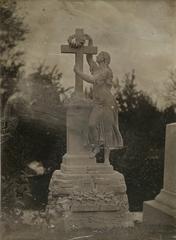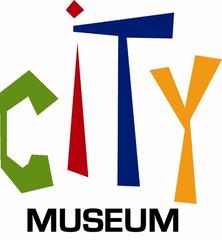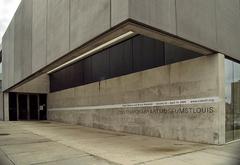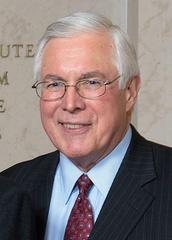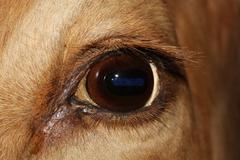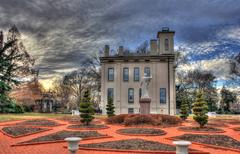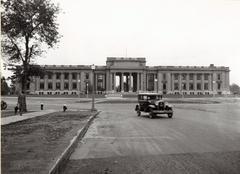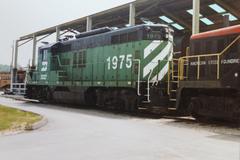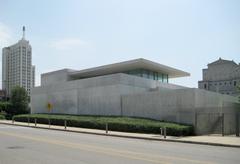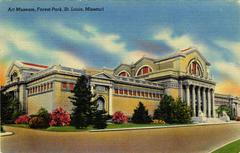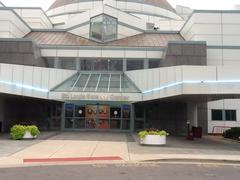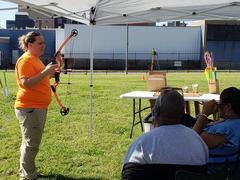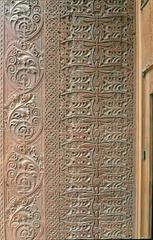Danforth Campus St. Louis: Comprehensive Visitor Guide for Hours, Tickets, and Attractions
Date: 04/07/2025
Introduction: The Legacy and Significance of Danforth Campus
Located just west of the iconic Forest Park in St. Louis, Missouri, the Danforth Campus of Washington University stands as a testament to both academic excellence and architectural grandeur. Established in 1853, the university’s relocation from downtown St. Louis to the elevated “Hilltop Campus” (now Danforth Campus) marks a history of growth, innovation, and commitment to education (campusnext.wustl.edu; washu.edu). The campus is renowned for its Collegiate Gothic architecture, featuring pointed arches, red granite, and limestone facades, blending seamlessly with modern, sustainable designs such as the East End Transformation project. This blend of heritage and innovation makes the Danforth Campus a must-visit for those interested in university culture and St. Louis history (kierantimberlake.com).
Historically significant as a site for the 1904 World’s Fair and Summer Olympics and as the location for Nobel Prize-winning scientific research, the campus welcomes visitors to explore its storied past and dynamic present. With free access to scenic grounds, cultural institutions like the Mildred Lane Kemper Art Museum, and the opportunity to join guided tours, the Danforth Campus offers an enriching experience for all (en.wikipedia.org; washu.edu). This guide provides detailed information on visiting hours, ticketing, transportation, accessibility, and top campus attractions, as well as nearby sites such as Forest Park and its museums and zoo. For the latest updates and interactive experiences, consult the official Washington University website and consider using the Audiala app (washu.edu; audiala.com).
Contents
- Introduction and History
- Key Historical Milestones
- Architectural Highlights and Sustainability
- Visiting Information: Hours, Tickets, and Tours
- Getting There and Parking
- Accessibility
- Must-See Sites and Attractions
- Special Events and Seasonal Highlights
- Visitor Tips and FAQs
- Nearby Attractions
- Summary and Final Tips
- References and Further Reading
Key Historical Milestones
Early Foundations and Campus Relocation
Founded in 1853 by Wayman Crow and William Greenleaf Eliot Jr., Washington University initially operated in downtown St. Louis (campusnext.wustl.edu). As the institution grew, a real estate committee led by Robert S. Brookings selected a 103-acre hilltop site just outside city limits, inspiring the campus’s “Hilltop” nickname. Landscape plans by Olmsted, Olmsted & Eliot and a national design competition won by Cope & Stewardson established the campus’s Collegiate Gothic identity (en.wikipedia.org; washu.edu).
1904 World’s Fair and Olympic Legacy
The campus’s construction accelerated thanks to a lease agreement with the organizers of the 1904 St. Louis World’s Fair, with several campus buildings serving as fair venues. Francis Field and Gymnasium, in particular, hosted events for the 1904 Summer Olympics (en.wikipedia.org).
Scientific Innovation and Historic Designation
In 1922, Arthur Holly Compton conducted Nobel Prize-winning research in the basement of Eads Hall, solidifying the campus’s reputation for scientific achievement. In 1987, the Danforth Campus was recognized as a National Historic Landmark District (en.wikipedia.org).
Renaming and Modern Transformation
Renamed the Danforth Campus in 2006 to honor former Chancellor William H. Danforth and the Danforth family’s contributions, the campus underwent a major transformation in 2019 with the $360 million East End project. This initiative added five new LEED-Gold-certified buildings, expanded the art museum, and created new green spaces (en.wikipedia.org; kierantimberlake.com).
Recent Developments and Challenges
In 2025, the university paused several capital projects due to federal funding uncertainties (universityherald.com; washu.edu). Additionally, a severe May 2025 storm caused moderate campus damage, prompting a swift university response (source.wustl.edu).
Architectural Highlights and Sustainability
The Danforth Campus is celebrated for its Collegiate Gothic buildings, designed by Cope & Stewardson and inspired by Oxford and Cambridge, featuring stonework, towers, and landscaped quadrangles. The East End Transformation introduced contemporary structures like the Gary M. Sumers Welcome Center, Schnuck Pavilion, and expanded Mildred Lane Kemper Art Museum, integrating sustainability through solar panels, green roofs, and underground parking (kierantimberlake.com). All new buildings are LEED-Gold certified, emphasizing the university’s commitment to environmental responsibility.
Visiting Information: Hours, Tickets, and Tours
Campus and Building Hours
- Campus Grounds: Open daily from 7:00 AM to 10:00 PM.
- Most Buildings: Open weekdays, 8:00 AM to 5:00 PM. Weekend and evening hours vary.
- Mildred Lane Kemper Art Museum: Tuesday–Saturday, 10:00 AM–5:00 PM; Sunday, 12:00 PM–5:00 PM; closed Mondays (Kemper Art Museum website).
Admission and Tickets
- Campus Grounds: Free access.
- Kemper Art Museum: Free general admission; special exhibits may require tickets.
- Guided Tours: Available during the academic year; book online or at the Welcome Center for in-depth campus history and architecture (washu.edu).
Getting There and Parking
- By Public Transit: MetroLink (Skinker or University City-Big Bend stations) and MetroBus provide direct access.
- By Car: GPS address: 6540 Snow Way, St. Louis, MO 63130. Parking is available in the East End, DUC, and Shepley Drive garages (paid).
- Ride-Share: Drop-off at the Danforth University Center or Sumers Welcome Center is recommended.
- Bicycle: Bike paths connect the campus to Forest Park and the regional greenways.
For maps and navigation, use the WashU Mobile App or pick up a printed map at campus information desks.
Accessibility
The Danforth Campus is ADA compliant, with accessible entrances, elevators, and restrooms across most buildings. For specific needs or assistance, contact visitor services in advance.
Must-See Sites and Attractions
Brookings Hall & Quadrangle
The campus’s iconic Collegiate Gothic centerpiece, Brookings Hall, anchors the scenic Brookings Quadrangle, a popular site for ceremonies and events.
Mildred Lane Kemper Art Museum
One of the country’s oldest teaching museums, the Kemper features modern and contemporary works and striking architecture (Kemper Art Museum website).
Danforth University Center (DUC)
The social hub featuring dining, lounges, and event spaces, open to visitors throughout the day.
Olin Library
A vibrant academic center with modern study areas and rotating exhibits.
Graham Chapel
A historic venue for concerts, lectures, and ceremonies.
East End Transformation Landmarks
Includes the Gary M. Sumers Welcome Center, Schnuck Pavilion, Ann and Andrew Tisch Park, and new engineering and design halls.
Outdoor Spaces and Sculpture Walks
Enjoy landscaped quads, Mudd Field, and public art by artists like Henry Moore and Alexander Calder.
Special Events and Seasonal Highlights
The campus hosts public events year-round, including art exhibitions, concerts, lectures, and athletic competitions at Francis Field. Notable annual highlights include commencement in May, Kemper Art exhibitions, and outdoor festivals.
Visitor Tips and Frequently Asked Questions
- Campus Maps: Available at the DUC, Schnuck Pavilion, or online.
- Guided Tours: Reserve in advance through the Admissions Office.
- Accessibility: Most attractions are wheelchair accessible; marked on maps.
- Dining: Options include the DUC, campus cafés, and food trucks.
- Photography: Permitted outdoors and in most public spaces.
- Best Times to Visit: The campus is most lively during the academic year (September–May).
FAQs:
- Q: What are visiting hours?
- A: Campus grounds: 7:00 AM–10:00 PM. Building hours vary.
- Q: Is admission free?
- A: Yes, except for some special events or exhibitions.
- Q: Are tours available?
- A: Yes, book through the Visitor Center or Admissions Office.
- Q: Is the campus accessible?
- A: Yes, with ADA-compliant facilities.
- Q: Where can I park?
- A: Visitor parking is available in designated garages.
Nearby Attractions
- Forest Park: Home to the Saint Louis Zoo, Missouri History Museum, and St. Louis Art Museum.
- Delmar Loop and Central West End: Dining and entertainment districts within walking distance.
Summary and Final Tips
The Danforth Campus perfectly blends rich history, architectural splendor, and innovative sustainability, offering a welcoming environment for all visitors. Free access to scenic grounds, acclaimed museums, and comprehensive tours enrich every visit. Nearby Forest Park and other St. Louis landmarks further expand your itinerary. For the latest updates, tour bookings, and interactive resources, consult the official university website and consider the Audiala app for enhanced exploration.
References and Further Reading
- Discovering the Danforth Campus: Visiting Hours, History, and Tips for Exploring Washington University in St. Louis, 2025, Campus Next
- Danforth Campus - Wikipedia, 2025
- Washington University in St. Louis Official Website, 2025
- East End Transformation - KieranTimberlake, 2019
- Washington University Halts Danforth Campus Construction Amid Federal Funding Uncertainty, 2025, University Herald
- Danforth Campus Suffers Moderate Damage in St. Louis Storm, 2025, WashU Source
- Visiting the Danforth Campus at Washington University in St. Louis: Hours, Tickets, and Architectural Highlights, 2025, WashU Source
